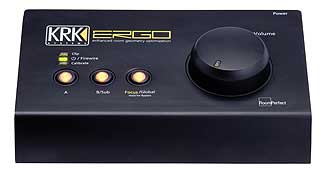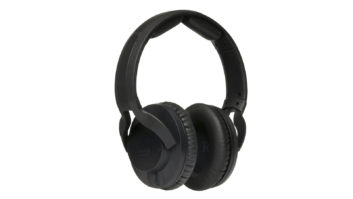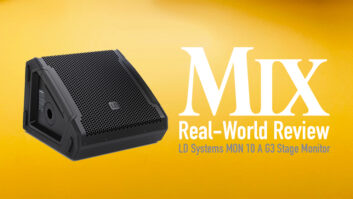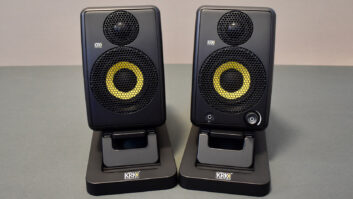
ERGO uses 1,024 dynamic filters to correct audio playback for two separate monitor systems.
KRK’s Enhanced Room Geometry Optimization (ERGO) is a stand-alone room acoustic correction system built into a hardware monitor controller unit. Its proprietary RoomPerfect™ technology corrects a room’s phase and frequency anomalies with the clear aim of realizing an acoustic space where crucial mixing decisions and overall sonic balances will translate to the outside world.
Simple, Yet Powerful
The ERGO unit includes a volume control and A/B speaker-selector buttons; a lighted thumbwheel level control for headphones is mounted on its side. The Focus/Global button toggles between Focus, which focuses correction on the mixing “sweet spot,” and Global for a wider area of correction. Holding the Focus/Global button triggers Bypass mode. ERGO’s rear panel has ¼-inch TRS jacks for balanced analog inputs and A and B speaker outs; a S/PDIF RCA jack input; a headphone jack; two FireWire ports; a Calibrate mode button; and the measurement mic’s input.
The ERGO system applies electronic corrections in the band of frequencies from 20 to 500 Hz by using 1,024 dynamic filters running at up to 96 kHz. By narrowing the focus of frequencies and by using all available DSP, ERGO achieves greater precision in both the measurement and subsequent correction processes. To measure a room using the included measurement microphone, ERGO requires a FireWire connection to either a PC or Mac running the ERGO Cal software. Once a measurement is made, its data is stored inside of the unit with no further computer connection required.
At the Proving Grounds
Here at my Tones 4 $ Studios, I have huge low-frequency issues. To try to reign in the problem, I installed bass trapping, diffusion and absorption panels. Afterward, I still heard so much bottom-end information in the 300 to 500Hz range that I (wrongly) compensated for it, which resulted in mixes that sounded very thin and spectrally poorly balanced when played outside of my room.

After installing the ERGO Cal software and connecting ERGO, I followed the onscreen steps and measured my room at different points. Each mic position adds to the system’s “Room Knowledge.” This process takes about 15 minutes.
I normally monitor my Pro Tools HD Accel rig digitally using the Digidesign 192 I/O’s AES/EBU enclosure output and the D/A converter in a Crane Song Avocet monitor controller. So I connected ERGO between the analog stereo monitor +4dBm line outputs of the Avocet’s speaker set 1 and my ADAM Audio S2.5A powered monitors. In this way, all connected monitor sources (CD player, 2-track deck, video, etc.) benefit from ERGO’s correction.
I also used ERGO’s S/PDIF input and preferred its D/A conversion (using an AKM AK4396 chip) to the Avocet’s conversion. The disadvantage of this hookup is that only the audio coming out of a DAW gets room correction. But if you need a monitor controller, by using ERGO’s D/A or FireWire I/O you avoid using an extra pair of AD/DA conversions for the most pristine monitor path possible.
Ergo, My Mixes Improved
ERGO has made a marvelous change in the accuracy of my monitors. With the LF problems ironed out, the individual tracks within the mix are clearer, making it easier to discern problems and make more accurate EQ decisions. Stereo imaging is the best I’ve heard, which makes precise pan positioning easier and the application of stereo-width effects — reverbs, delays, micro-delays and phase trickery — more exact. The only downside to using ERGO was “zipper” noise when adjusting volume. (KRK is aware of this problem and is working on a solution.) Also, there should be multiple monitoring source selection switching.
My clients report that my mixes are now “dialed in” and “spot on.” There is solid low end without tubbiness and clarity without excessive treble boosts; vocals sit correctly, and dynamics respond accurately. I’ve been using ERGO mixing every day during a two-week period, and it has improved the quality of my work.
Barry Rudolph is an L.A.-based recording engineer/mixer. Visit
www.barryrudolph.com.







